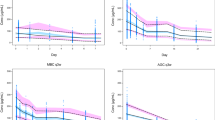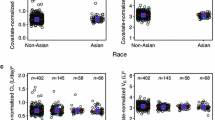Abstract
Trastuzumab-DM1 (T-DM1) is a novel antibody–drug conjugate under investigation for the treatment of human epidermal growth factor receptor 2 (HER2)-positive metastatic breast cancer. One challenge in oncologic drug development is determining the optimal dose and treatment schedule. A novel dose regimen-finding strategy was developed for T-DM1 using experimental data and pharmacokinetic/pharmacodynamic modeling. To characterize the disposition of T-DM1, pharmacokinetic studies were conducted in athymic nude and beige nude mice. The pharmacokinetics of T-DM1 were described well by a two-compartment model. Tumor response data were obtained from single-dose, multiple-dose and time–dose-fractionation studies of T-DM1 in animal models of HER2-positive breast cancer, specifically engineered to be insensitive to trastuzumab. A sequential population-based pharmacokinetic/pharmacodynamic modeling approach was developed to describe the anti-tumor activity of T-DM1. A cell-cycle-phase nonspecific tumor cell kill model incorporating transit compartments captured well the features of tumor growth and the activity of T-DM1. Key findings of the model were that tumor cell growth rate played a significant role in the sensitivity of tumors to T-DM1; anti-tumor activity was schedule independent; and tumor response was linked to the ratio of exposure to a concentration required for tumor stasis.








Similar content being viewed by others
References
O’Shaughnessy J, Vukelja SJ, Marsland T, Kimmel G, Ratnam S, Pippen J (2002) Phase II trial of gemcitabine plus trastuzumab in metastatic breast cancer patients previously treated with chemotherapy: preliminary results. Clin Breast Cancer 3(Suppl 1):17–20
Pegram MD, Pienkowski T, Northfelt DW, Eiermann W, Patel R, Fumoleau P, Quan E, Crown J, Toppmeyer D, Smylie M, Riva A, Blitz S, Press MF, Reese D, Lindsay MA, Slamon DJ (2004) Results of two open-label, multicenter phase II studies of docetaxel, platinum salts, and trastuzumab in HER2-positive advanced breast cancer. J Natl Cancer Inst 96:759–769
Vogel CL, Cobleigh MA, Tripathy D, Gutheil JC, Harris LN, Fehrenbacher L, Slamon DJ, Murphy M, Novotny WF, Burchmore M, Shak S, Stewart SJ, Press M (2002) Efficacy and safety of trastuzumab as a single agent in first-line treatment of HER2-overexpressing metastatic breast cancer. J Clin Oncol 20:719–726
Chari RV, Martell BA, Gross JL, Cook SB, Shah SA, Blattler WA, McKenzie SJ, Goldmacher VS (1992) Immunoconjugates containing novel maytansinoids: promising anticancer drugs. Cancer Res 52:127–131
Lewis Phillips GD, Li G, Dugger DL, Crocker LM, Parsons KL, Mai E, Blattler WA, Lambert JM, Chari RV, Lutz RJ, Wong WL, Jacobson FS, Koeppen H, Schwall RH, Kenkare-Mitra SR, Spencer SD, Sliwkowski MX (2008) Targeting HER2-positive breast cancer with trastuzumab-DM1, an antibody–cytotoxic drug conjugate. Cancer Res 68:9280–9290
Spector NL, Blackwell KL (2009) Understanding the mechanisms behind trastuzumab therapy for human epidermal growth factor receptor 2-positive breast cancer. J Clin Oncol 27:5838–5847
Nahta R, Yu D, Hung MC, Hortobagyi GN, Esteva FJ (2006) Mechanisms of disease: understanding resistance to HER2-targeted therapy in human breast cancer. Nat Clin Pract Oncol 3:269–280
Pohlmann PR, Mayer IA, Mernaugh R (2009) Resistance to trastuzumab in breast cancer. Clin Cancer Res 15:7479–7491
Hall EJ (1994) Radiobiology for the radiologist, 4th edn. Lippincott, Williams & Wilkins, Philadelphia, PA
Drusano GL, Craig WA (1997) Relevance of pharmacokinetics and pharmacodynamics in the selection of antibiotics for respiratory tract infections. J Chemother 9:S38–S44
Gunderson BW, Ross GH, Ibrahim KH, Rotschafer JC (2001) What do we really know about antibiotic pharmacodynamics? Pharmacotherapy 21:302S–318S
Rocchetti M, Poggesi I, Germani M, Fiorentini F, Pellizzoni C, Zugnoni P, Pesenti E, Simeoni M, De Nicolao G (2005) A pharmacokinetic-pharmacodynamic model for predicting tumour growth inhibition in mice: a useful tool in oncology drug development. Basic Clin Pharmacol Toxicol 96:265–268
Simeoni M, Magni P, Cammia C, De Nicolao G, Croci V, Pesenti E, Germani M, Poggesi I, Rocchetti M (2004) Predictive pharmacokinetic-pharmacodynamic modeling of tumor growth kinetics in xenograft models after administration of anticancer agents. Cancer Res 64:1094–1101
Magni P, Simeoni M, Poggesi I, De Nicolao G (2006) A mathematical model to study the effects of drugs administered on tumor growth dynamics. Math Biosci 200:127–151
Rocchetti M, Simeoni M, Pesenti E, De Nicolao G, Poggesi I (2007) Predicting the active doses in humans from animal studies: a novel approach in oncology. Eur J Cancer 43:1862–1868
Parsons KL, Crocker L, Leipold DD, Li G, Tien J, Dugger D, Lewis Phillips G, Ross S, Tibbitts J, Sliwkowski MX (2007) In 98th American Association for Cancer Research Annual Meeting, Los Angeles, CA
Jumbe NL (2007) Quantitative translational pharmacology for monoclonal antibody dose and dose-schedule determination. Am Pharm Rev 10:111–117
Lo CF (2007) Stochastic Gompertz model of tumour cell growth. J Theor Biol 248:317–321
McAneney H, O’Rourke SF (2007) Investigation of various growth mechanisms of solid tumour growth within the linear-quadratic model for radiotherapy. Phys Med Biol 52:1039–1054
Mager DE, Jusko WJ (2001) Pharmacodynamic modeling of time-dependent transduction systems. Clin Pharmacol Ther 70:210–216
Kozusko F, Bourdeau M (2007) A unified model of sigmoid tumour growth based on cell proliferation and quiescence. Cell Prolif 40:824–834
Panetta JC (1997) A mathematical model of breast and ovarian cancer treated with paclitaxel. Math Biosci 146:89–113
Lobo ED, Balthasar JP (2002) Pharmacodynamic modeling of chemotherapeutic effects: application of a transit compartment model to characterize methotrexate effects in vitro. AAPS PharmSci 4:E42
Favini F, Sultan I, Meazza C, Casanova M, Ferrari A (2009) Prognostic role of tumor size in childhood cancer. Future Oncol 5:1605–1613
Ionta MT, Atzori F, Deidda MC, Pusceddu V, Palmeri S, Frau B, Murgia M, Barca M, Minerba L, Massidda B (2009) Long-term outcomes in stage IIIB breast cancer patients who achieved less than a pathological complete response (<pCR) after primary chemotherapy. Oncologist 14:1051–1060
van Akkooi AC, Nowecki ZI, Voit C, Schafer-Hesterberg G, Michej W, de Wilt JH, Rutkowski P, Verhoef C, Eggermont AM (2008) Sentinel node tumor burden according to the Rotterdam criteria is the most important prognostic factor for survival in melanoma patients: a multicenter study in 388 patients with positive sentinel nodes. Ann Surg 248:949–955
Zhang L, Beal SL, Sheiner LB (2003) Simultaneous vs. sequential analysis for population PK/PD data I: best-case performance. J Pharmacokinet Pharmacodyn 30:387–404
Zhang L, Beal SL, Sheinerz LB (2003) Simultaneous vs, sequential analysis for population PK/PD data II: robustness of methods. J Pharmacokinet Pharmacodyn 30:405–416
Davies B, Morris T (1993) Physiological parameters in laboratory animals and humans. Pharm Res 10:1093–1095
Vacha J (1975) Blood volume in inbred strain BALB/c, CBA/J and C57BL/10 mice determined by means of 59Fe-labelled red cells and 59Fe bound to transferrin. Physiol Bohemoslov 24:413–419
Peterson JK, Houghton PJ (2004) Integrating pharmacology and in vivo cancer models in preclinical and clinical drug development. Eur J Cancer 40:837–844
Beeram M, Burris HA, Modi S, Birkner M, Girish S, Tibbitts J, Holden SN, Lutzker SG, Krop IE (2008) A phase I study of trastuzumab-DM1 (T-DM1), a first-in-class HER2 antibody–drug conjugate (ADC), in patients (pts) with advanced HER2+ breast cancer (BC). J Clin Oncol 26
Krop IE, Mita M, Burris HA, Birkner M, Girish S, Tibbitts J, Holden SN, Lutzker SG, Modi S (2009) A phase I study of weekly dosing of trastuzumab-DM1 (T-DM1) in patients with advanced HER2+ breast cancer. Cancer Res 69:3136
Vogel CL, Burris HA, Limentani S, Borson R, O’Shaughnessy J, Vukelja S, Agresta B, Klencke B, Birkner M, Rugo H (2009) A phase II study of trastuzumab-DM1 (T-DM1), a HER2 antibody-drug conjugate (ADC), in patients (pts) with HER2+ metastatic breast cancer (MBC): final results. J Clin Oncol 27
Author information
Authors and Affiliations
Corresponding author
Additional information
In this study, pharmacokinetic/pharmacodynamic modeling successfully integrated the exposure–anti-tumor activity relationships providing insight on a predicted efficacious clinical dose and dosing regimen for T-DM1.
Rights and permissions
About this article
Cite this article
Jumbe, N.L., Xin, Y., Leipold, D.D. et al. Modeling the efficacy of trastuzumab-DM1, an antibody drug conjugate, in mice. J Pharmacokinet Pharmacodyn 37, 221–242 (2010). https://doi.org/10.1007/s10928-010-9156-2
Received:
Accepted:
Published:
Issue Date:
DOI: https://doi.org/10.1007/s10928-010-9156-2




